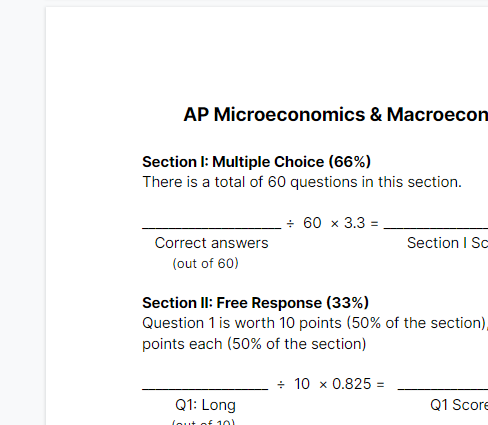You’ll learn about the content and format of each exam, as well as the skills and knowledge they test. We’ll also share insider tips on how to prepare effectively for each exam, including recommended study resources and practice strategies.
By the end of this article, you’ll have a clear understanding of which AP Physics exam is right for you and how to maximize your chances of success. Whether you’re a high school student aiming for college credit or a motivated learner looking to expand your physics skills, this guide is a must-read. Start preparing for your AP Physics exam today with our expert advice!”
1. Overview of the AP Physics Exam
There are a total of 4 AP Physics exams: AP Physics 1, AP Physics 2, AP Physics C: Electricity and Magnetism, and AP Physics C: Mechanics. The main contents of each subject exam are as follows:
AP Physics 1: is a full-year course that is the equivalent of a first-semester introductory college course in algebra-based physics. Topics covered include: kinematics, dynamics, circular motion and gravitation, energy, momentum, simple harmonic motion, torque, and rotational motion, electric charge and electric force, DC circuits, and mechanical waves and sound.
AP Physics 2: is a full-year course, equivalent to a second-semester introductory college course in physics. Students are expected to learn fluids; thermodynamics; electrical force, field, and potential; electric circuits; magnetism and electromagnetic induction; geometric and physical optics; and quantum, atomic, and nuclear physics.
AP Physics C: Mechanics: is a half-year course equivalent to a semester-long, introductory calculus-based college course. It covers kinematics; Newton’s laws of motion; work, energy, and power; systems of particles and linear momentum; circular motion and rotation; oscillations; and gravitation.
AP Physics C: Electricity and Magnetism is a half-year course following Physics C: Mechanics and is equivalent to a semester-long, introductory calculus-based college course.
The course explores topics such as electrostatics; conductors, capacitors, and dielectrics; electric circuits; magnetic fields; and electromagnetism. Introductory differential and integral calculus are used throughout the course.
2. AP Physics Course Prerequisites
- AP Physics 1: There are no specific prerequisites for AP Physics 1, but it is recommended that students have completed a high school algebra course and have taken or are concurrently enrolled in a trigonometry course.
- AP Physics 2: The prerequisite for AP Physics 2 is successfully completing AP Physics 1 or a similar introductory physics course.
- AP Physics C: Electricity and Magnetism: The prerequisite for AP Physics C: Electricity and Magnetism is the successful completion of either AP Physics 1 and 2 or a similar introductory physics course, as well as a calculus course or concurrent enrollment in a calculus course.
- AP Physics C: Mechanics: The prerequisite for AP Physics C: Mechanics is the successful completion of either AP Physics 1 and 2 or a similar introductory physics course, a calculus course or concurrent enrollment in a calculus course.
Algebra 2 is oftentimes also a prerequisite for AP Physics. Algebra 2 provides the mathematical foundation necessary to understand and solve problems in AP Physics. AP Physics involves the application of mathematical concepts such as algebra, trigonometry, and calculus to describe and explain physical phenomena.
In Algebra 2, students learn advanced algebraic concepts such as functions, quadratic equations, exponential and logarithmic functions, and systems of equations. These concepts are essential for solving physics problems that involve motion, forces, energy, and other phenomena.
Without a solid understanding of Algebra 2, it can be challenging to understand the mathematical equations and concepts used in AP Physics. Therefore, students interested in taking AP Physics should ensure they have a strong foundation in Algebra 2 and are comfortable with its concepts before diving into AP Physics.
2. Exam Information
AP Physics 1
- Exam time: 3 hours
- Exam distribution:
Section I: Multiple choice questions: 50 questions, 1 hour and 30 minutes in total, accounting for 50% of the test score
Section II Paper Exam: Short answer questions: 5 questions, 1 hour and 30 minutes in total, accounting for 50% of the test score. 5 free-response questions are divided into Experimental Design questions (1 question), Qualitative/Quantitative Translation (1 question), short answer questions (3 questions, one requires a longer explanation – Paragraph Argument)
Section II Digital Exam: Multiple Choice and Free Response questions, accounting for 50% of test score. 25 multiple-choice questions, and 2 free-response questions. Free-response questions are divided into Qualitative/Quantitative Translation (1 question) and Short Answer: Paragraph Argument (1 question)
AP Physics 2
- Exam time: 3 hours
- Exam distribution:
Section I: Multiple choice questions: 50 questions, 1 hour and 30 minutes in total, accounting for 50% of the test score
Section II Paper Exam: Short answer questions: 4 questions, 1 hour and 30 minutes in total, accounting for 50% of the test score. Questions are divided into Experimental Design questions (1 question), Qualitative/Quantitative Translation (1 question), short answer questions (2 questions, one requires a longer explanation – Paragraph Argument)
Section II Digital Exam: Multiple Choice and Free Response section, accounting for 50% of test score. 25 multiple-choice questions, and 2 free-response questions. Free-response questions are divided into Qualitative/Quantitative Translation (1 question) and Short Answer: Paragraph Argument (1 question)
- Exam time:1 hour 30 minutes
- Exam distribution:
- Exam time: 1 hour 30 minutes
- Exam distribution:
3. Taking into consideration college credits
We provide examples from Northeastern University about the college credits it grants for AP Physics during the 2020-2021 school year.
Northeastern accepts AP scores of 4 or 5 for credit:
- Physics 1: can be counted as 5 semester hours equivalent to the class PHYS1145/1146: Physics for Life Sciences 1/Lab
- Physics 2: can be counted as 5 semester hours equivalent to the class PHYS1147/1148 Physics for Life Sciences 2/Lab
- Physics C: Electricity and Magnetism can be counted as 5 semester hours equivalent to the classes PHYS1155/1156 & PHYS1157: Physics for Engineering 2/Lab & Interactive Learning for PHSY1155
- Physics C: Mechanics can be counted as 5 semester hours equivalent to the classes PHYS1151/1152 & 1153 Physics for Engineering 1/Lab & Interactive Learning for PHYS1151
Any degree within the Physics department, for instance, Chemical Engineering and Physics, requires 10 semester hours of study in Physics 1x to complete its Mathematics/Science requirements, out of 139 total semester hours required.
From the financial perspective, transferring AP exam scores to 10 semester hours in college will save you $1,699/semester hour, and a total of $16,990 for 10 semester hours.
From the coursework perspective, having 10 semester hours transferred in allows you to keep your college coursework options open, as you can register for more courses tailored to your interests.
4. How to choose the right AP Physics Exam?
5. Score Distribution
| Subject | 5 points | 4 points | 3 points | 2 minutes | 1 point |
| AP Physics 1 | 6.9% | 16.3% | 18.9% | 26.4% | 31.4% |
| AP Physics 2 | 15.4% | 17.9% | 32% | 27% | 7.6% |
| AP Physics C Electricity and Magnetism | 32.6% | 23.1% | 13.8 | 18% | 12.5% |
| AP Physics C Mechanics | 23.5% | 28.6% | 21.3% | 14.9% | 11.6% |
Introducing Aralia Test Preparation Bootcamp, where students can excel in standardized tests with our comprehensive approach. At Aralia, we prioritize maximizing study efficiency and accelerating score improvement through a combination of practice examinations, expert strategies, and personalized guidance. Our Bootcamp offers students the opportunity to achieve significant score improvements within a condensed timeframe by learning strategic approaches tailored to their individual needs. With instructors who are AP readers, students benefit from expert teaching and gain valuable insights into exam techniques. Furthermore, our program equips students with versatile skills and strategies that can be applied to a range of standardized tests, ensuring they are well-prepared to adapt to various exam types.

FREE AP Scoring Worksheet
With the scoring worksheet, you will be able to calculate your target score in preparation for the upcoming exam in May. We also have a full scoring worksheet available below if you want to print it out and keep it in your folder.
This online course is the perfect opportunity for students to prepare to take an AP Physics course at their host institution. Taught by an experienced AP Physics teacher, this interactive course focuses on strong conceptual development in the most challenging areas of the AP Physics curriculum. The online sessions will cover the salient points in the most traditionally arduous areas of the College Board’s curriculum, beginning with kinematics, dynamics, circular motion and gravitation, work and energy, impulse and momentum, rotational mechanics, and finally oscillations and harmonic oscillators.










